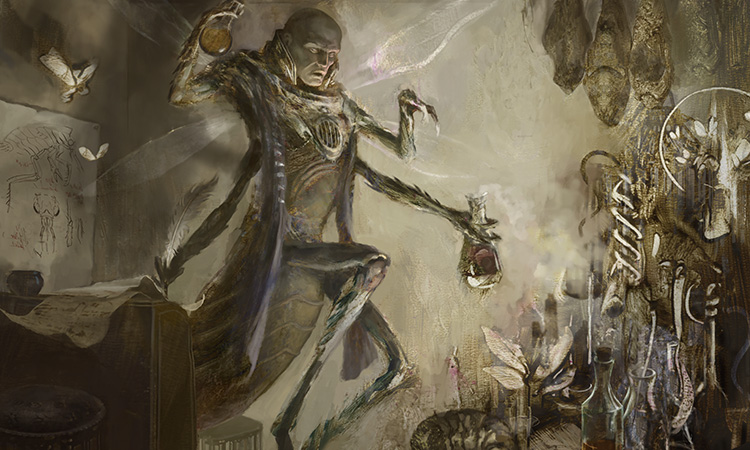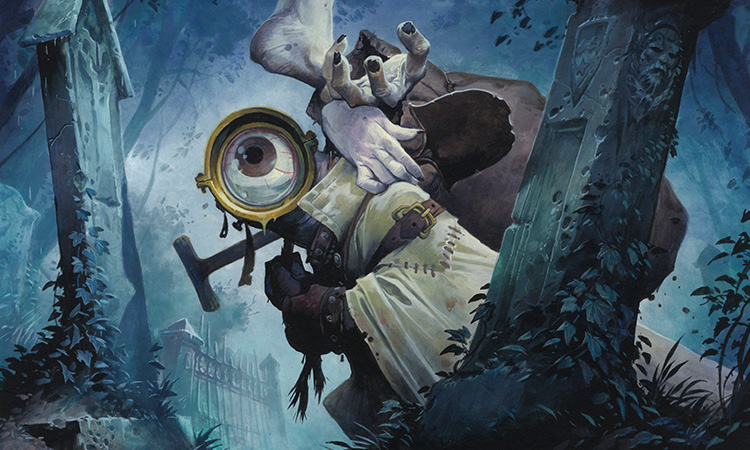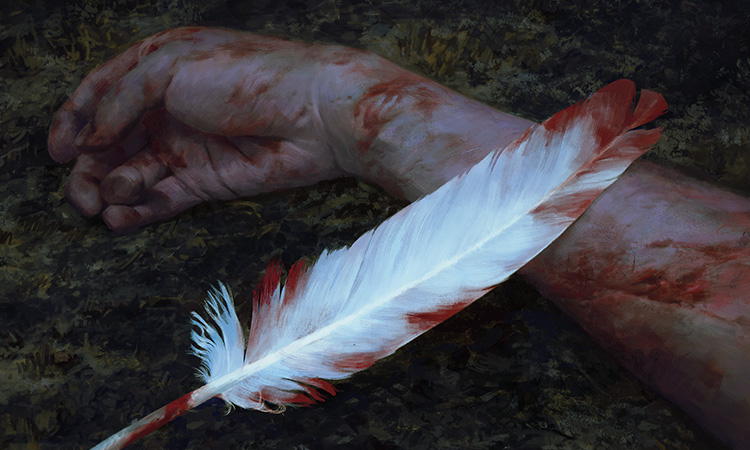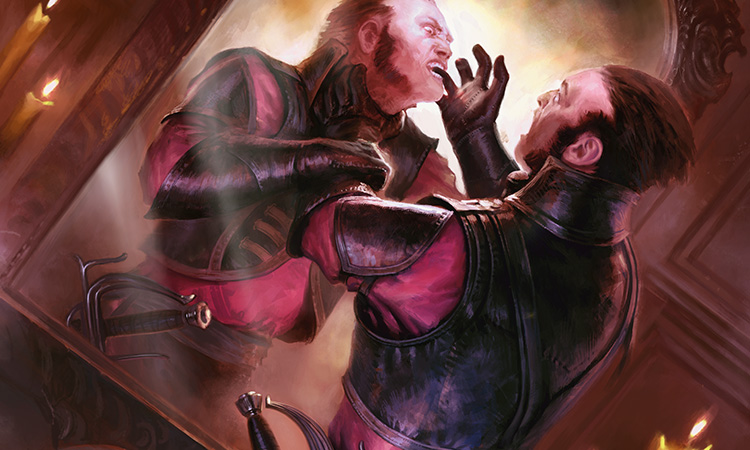Push and Pull
The Unstoppable Force Meets the Immovable Object
I often talk about how Magic is a game of change. It's constantly evolving, reinventing itself. But at the same time, it's a game of stability. The game of Magic you play today can't be all that different from the game of Magic you play next year. It needs to be familiar and recognizable. How can it be both? Don't those two things work in opposite directions? They do, which creates the most basic tension in Magic design.
Game of Change
The average Magic player has now played the game for close to ten years. Ten years! That's longer than the average game survives. How is that possible? My go-to answer is what I call my Crispy Hash Brown Theory. (Skip the next paragraph if you've heard me explain this enough times already.)
When you eat hash browns, the best part is the crispy outer shell. Yeah, you'll eat the inside after you get through the crispy part, but it's just not the same. With games, I believe the crispy shell is the exploratory part of a game, where you're trying to figure out what makes it tick. There's a lot of fun in mapping out all of a game's components and then figuring out the optimal strategy to win (even if you don't always end up using it). Once you work through that part, advancement in games starts becoming more rote, more about memorization and less about exploring. In chess, for example, you start studying opening moves. In Scrabble, you begin learning the two- and three-letter words. Magic gets around this problem by constantly regrowing its crispy outer shell. Whenever you think you've finally cracked Magic, it changes out from under you as new cards appear and older cards rotate out.
Magic's identity is all about its constant evolution. In fact, whenever we do previews, the first thing players want to know is what's the new thing? What's the new world? What's the new theme? What are the new mechanics? What are the new cards? What's the new crispy outer shell going to be?
As designers, that means it's our job to make sure that we're constantly challenging the players. I often joke that the players are like the Borg from Star Trek, a cybernetic alien race with a hive mind that has the ability to develop counter-strategies to each weapon once it's used on them. Every new trick works once, and then the players assimilate it and consider it part of the game, meaning that with each expansion we're trying to find something new that the players haven't experienced yet.
This constant evolution is more than just a means to entertain the players. It's the key to Magic's identity. The constant churn of new cards and new ideas is the most defining trait of the game. To continue my slew of metaphors, Magic is a shark that must keep swimming or die. Magic doesn't want change, it needs change.

Game of Stability
A majority of Magic players will take a break at some point in their Magic-playing history. We've monitored players for years, and one common trait is that things change in the players' lives—they change jobs, they change cities, they change social situations, they change schedules. Life sometimes just gets in the way, and it is common for players to stop playing for some length of time. Some keep a toe in. Some read a website or follow an online Magic community. Some hear from friends who still play. Some just google "Magic: The Gathering" every once in a while. Things eventually change again, and they'll often return to the game. When they do, it's important that Magic is still the same game.
In my column on communications theory, I talked about the importance of surprise, but I stated that before that can happen, you have to create a sense of comfort. Yes, Magic can change, but only if it first lays a groundwork of familiarity. You want players to be able to jump into any new set with the comfort of knowing that they have the basics down. Yes, there are going to be new things, but they're presented alongside lots of old, known things.
Note that familiarity can be a selling point. Returning to old worlds has proven popular. Bringing back old mechanics has been successful. Players enjoy having things that they recognize from before. Magic players fell in love with the game of Magic, and that sense of comfort is key to the game's continued success.
Living on the Edge
So what happens if one of these two forces wins?
If Magic were all about change and not stability, each set would be radically different, and over time the game would shift away from where it started. Players who came back to the game wouldn't recognize it and would have to essentially learn a brand-new game. Complexity would most likely go through the roof because players would have to be constantly learning huge swaths of new rules. The game would quickly become inaccessible to all but its most diehard fans.
If Magic were all about stability and not change, there might not even be new sets. Magic would just be as it always was. The strategy would get figured out and deck innovation would stop being a thing. The average player would probably play less, and from a business standpoint, the game would have some big financial issues.
Each force adds something important to the game, so we have to figure out how to keep them in balance.
Prose and Conflicts
Let's explore different ways this tension plays out in game design.
Head Designer vs. Rules Manager
When I first pitched the idea of split cards, the rules manager told me we could do them by writing the cards out as modal cards. We didn't need the crazy two-card layout. When I first suggested we do double-faced cards, the rules manager said we could do them as flip cards (the cards from Champions of Kamigawa block that flipped their orientation). Whenever I come up with a new idea, the rules manager is there to figure out how we can use existing technology to make it work.

But here's the problem—as head designer, I'm often trying to find a novel way of doing something. I wasn't interested in making more flip cards. I wanted to make double-faced cards. I realized that they had the potential to be a big talking point of the set. I wanted them to be different. The rules manager had a different set of goals. They want the rules to work. If there's a way to accomplish something new with the rules that already exist, all the better. Every time you add a new component to the rules, you risk breaking things and causing problems. That doesn't mean the rules manager is against making new rules, but they want to limit themselves to things that need new rules because there isn't any other way to do them.
New Card vs. Reprint
New cards give you freedom as a designer to do whatever you need to do to make the set work. New cards create fewer restrictions when building a set. New cards let you as a designer creatively express yourself. New cards are exciting. New cards sell sets. New cards create innovation.
Reprints are easier to make. Reprints allow players to make use of cards they already own. Reprints are easier to develop, as there's a history of the card to look at. Reprints are more familiar. Reprints have potential nostalgia. Reprints help you set expectations, as the audience understands better what to expect from them. Reprints are lower in complexity because some of the players already have knowledge of how they work.
I should note this conflict could just as well be about new mechanics versus returning mechanics or new worlds versus revisits. There's a lot of pressure to both explore virgin design space and return to things that were popular.
Unknown vs. Known
In Hollywood, there's something known as a three-beat. It's where sell your new idea by taking two popular older things and mashing them together. ("It's The Lego Movie meets Mad Max: Fury Road.") The reason this technique is popular in Hollywood is because it allows you to take a new idea and sell it in the context of old ideas. It's something fresh and new because it mixes and matches in a way that hasn't been done before, but it's old and reliable because it's making use of known successful commodities.
This tension for things to be both unknown and known happens in making Magic sets as well. For example, if I have an idea for a new block, I have several layers of people above me to convince that it's a good idea. If my idea is too unknown, it's a hard sell because I have to convince them that although we've never done this thing before, players will like it. If it's too known without enough of a new spin on it, there will be worries that we're just rehashing old ideas and it won't be innovative enough.
Breaking the Tension
So what's the solution to this problem? How are we able to be both a game of change and a game of stability at the same time? I'm going to explain using Shadows over Innistrad as my example.
- Strike the Right Balance
An expression I like is "Tension is what holds up a tepee." You start building a tepee by taking a number of poles and laying them against one another. Each pole by itself wants to fall in a different direction. It is only by creating a lattice of them pushing against one another that you are able to create something solid.
The first solution to the problem is seeing the tension as something productive. Each force helps keep the other in check. For example, with Shadows over Innistrad, we wanted to make sure that the set felt like a return to a beloved plane but also had its own identity. The solution was to start with Gothic horror but find some new way to approach it. Once we stumbled upon the idea of mystery and madness being our themes, we realized that we could deliver on Gothic horror without just repeating what we had done the last time we visited Innistrad.

Another way to accomplish this is understanding the forces at hand and then making sure you're allocating the correct amount of resources for each. During my preview weeks, I talked about how we wrote down everything that the original Innistrad block did mechanically and then ranked how important it was to the return. We then took that priority ranking and lined everything up in order. Next we explored what would happen if we moved where we set the line for what made it into the set. To use my tepee metaphor, we were testing the poles against one another to find the right balance where they would hold each other up.
A lot of knowing what the right balance is comes down to it feeling correct. Having done this for a long time, I've gotten a good instinct for it. No matter where we set the line, though, we always playtest, because it is only through actually playing with a set that you can see if your instincts were right.
- Understand the Strength of Each Force
The first lesson talks about quantity. You have to have the right mix to make sure the two forces keep each other in place. This second lesson is more about quality than quantity. Yes, the two forces press against one another, but that doesn't mean they're the same. Each plays a different role and thus has different strengths.
Shadows over Innistrad was a return block. That means that one of its goals was making sure the world matched its previous feel. We were looking for familiarity and comfort, which meant it was playing to the strengths of the force of stability. Knowing that influenced how we put the set together. The simplest way to think of it is this—a set has two main components: the keywords and the environment. In a new world, the environment picks up the slack of creating a sense of change, meaning you lean more on the keywords to create a sense of stability. In Shadows over Innistrad, the opposite was true, so we leaned on the environment to create a sense of stability and the keywords to create a sense of change.
This is why, for example, we didn't repeat a lot of keywords. We needed the keywords to convey a sense of change. Instead, we leaned on the mechanical components that helped craft the environment—double-faced cards, tribal synergy, graveyard interactions, things that reinforced the mechanical feel of the world without being keywords. Understanding the role of each force is instrumental in knowing where to focus the design and choosing where one needs to innovate.
- Change Up Where You Apply Each Force
This lesson is a corollary to the last one. If each force has its own strength, then it's important for us to mix up sets such that different sets play to different strengths. This is, for instance, one of the reasons we've chosen to do about half the worlds as new and half as returns. Each plays into the strength of a different force.
I talk all the time about how I like to start each design from a different vantage point. I also like to make sure that each design is taking advantage of different aspects of the game. Sometimes the force of change is guiding me, while other times it's more the force of stability. The key is mixing it up so that I'm not always using the forces in the same capacity.

- Create Elements That Combine the Two
Almost every block has a Giant Growth variant that makes use of one of the block mechanics. It's used so often that players love to make fun of it, but have you ever thought about why it's a staple of design? It's a way for us to mix the force of change with the force of stability.
You see, Magic has certain effects that we need to do in every block because they are key to the basic experience of a Magic game. An important part of keeping the game familiar is making sure a majority of those key components show up in every set. A few can be reprints, but if we have too much duplication from set to set, it feels stale. That's where the new mechanic comes in. It's what will make the newest Magic set feel different.
Combining the new mechanic with the needed effect allows us to essentially have our cake and eat it too. The Giant Growth variant fills the role of being a Giant Growth and allowing the game to function like it normally does, but the new mechanic helps tweak things so it works a little differently than it has in the past. This mix of old and new is key to helping the two forces find balance.
May the Forces Be with You
All in all, I've come to see this tension as a valuable tool to make the game. The existence of each force helps keep me and my designers on our toes so that we never forget to have a proper balance. Hopefully, my peek into this basic element of the game has shed some light onto yet another facet of Magic that design (and development) must always keep in mind.
As always, I'm interested in hearing your feedback. You can email me or contact me through any of my social media accounts (Twitter, Tumblr, Google+, and Instagram).
Join me next week, when I apply the Storm Scale to some older mechanics.
Until then, may Magic always be different yet the same.
"Drive to Work #324—Leaks"
In this podcast I talk about my dislike for leaks and explain why in detail.
"Drive to Work #325—Magic: The Puzzling"
This podcast looks back to the thing that first got me involved with Wizards and making Magic-related things—my puzzle column from the Duelist.
- Episode 325 Magic: The Puzzling (16.7 MB)
- Episode 324 Leaks (19.4 MB)
- Episode 323 Late Changes (15.0 MB)
- Episode 322 T-Shirts (19.2 MB)
- Episode 321 Top 10 Sets I've Designed (16.4 MB)

